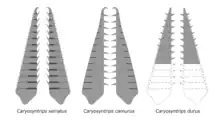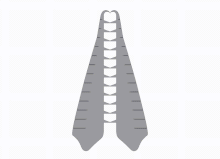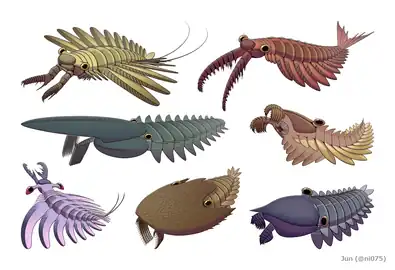Caryosyntrips
Caryosyntrips ("nutcracker") is an extinct genus of radiodont which known from Canada, United States and Spain during the middle Cambrian. Caryosyntrips is known only from its 14-segmented frontal appendages, which resemble nutcrackers, recovered from the Burgess Shale Formation, Canada Wheeler Shale and Marjum Formation, United States, and Valdemiedes Formation, Spain.[1][2] It was first named by Allison C. Daley, Graham E. Budd in 2010 and the type species is Caryosyntrips serratus.[3] Caryosyntrips is thought to have used their appendages in a scissor-like grasping or slicing motion, and were probably durophagous, feeding on hard-shelled organisms. Due to the unusual morphology of the frontal appendages and the limited extent of known remains, its position within Radiodonta remains uncertain.[1]
| Caryosyntrips Temporal range: | |
|---|---|
 | |
| Frontal appendages of Caryosyntrips | |
 | |
| Speculative life restoration | |
| Scientific classification | |
| Domain: | Eukaryota |
| Kingdom: | Animalia |
| Phylum: | Arthropoda |
| Class: | †Dinocaridida |
| Order: | †Radiodonta |
| Genus: | †Caryosyntrips Daley & Budd, 2010 |
| Type species | |
| Caryosyntrips serratus Daley & Budd, 2010 | |
| species | |

References
- Stephen Pates; Allison C. Daley (2017). "Caryosyntrips: a radiodontan from the Cambrian of Spain, USA and Canada". Papers in Palaeontology. 3 (3): 461–470. doi:10.1002/spp2.1084. S2CID 135026011.
- Pates, Stephen; Lerosey-Aubril, Rudy; Daley, Allison C.; Kier, Carlo; Bonino, Enrico; Ortega-Hernández, Javier (2021-01-19). "The diverse radiodont fauna from the Marjum Formation of Utah, USA (Cambrian: Drumian)". PeerJ. 9: e10509. doi:10.7717/peerj.10509. ISSN 2167-8359. PMC 7821760. PMID 33552709.
- Allison C. Daley, Graham E. Budd (2010). "New anomalocaridid appendages from the Burgess Shale, Canada". Palaeontology. 53 (4): 721–738. Bibcode:2010Palgy..53..721D. doi:10.1111/j.1475-4983.2010.00955.x.
External links
- "Caryosyntrips serratus". Burgess Shale Fossil Gallery. Virtual Museum of Canada. 2011. Archived from the original on 2020-11-12.
